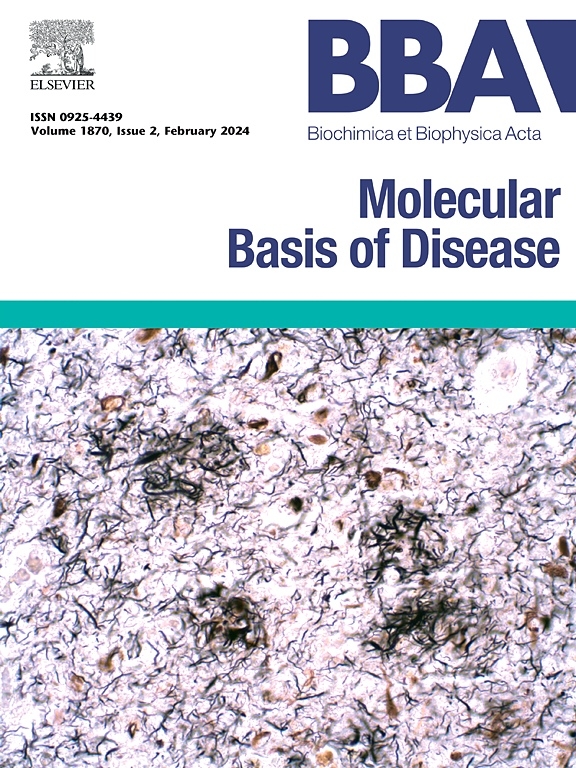Nop2/Sun domain family member 5 contributes to tumorigenic properties in prostate cancer by engaging the PI3K-AKT pathway and tumor-associated macrophages
IF 4.2
2区 生物学
Q2 BIOCHEMISTRY & MOLECULAR BIOLOGY
Biochimica et biophysica acta. Molecular basis of disease
Pub Date : 2025-07-07
DOI:10.1016/j.bbadis.2025.167974
引用次数: 0
Abstract
Purpose
Nop2/Sun domain family member 5 (NSUN5), a member of the m5C methylation family, plays a critical role in various biological processes by influencing RNA stability and regulating gene expression. The main purpose of this study was to determine the specific role of NSUN5 in prostate cancer (PCa) progression.
Methods
TCGA-PRAD database was used to analyze the differential expression of NSUN5 between PCa and normal tissues, as well as its association with survival outcomes, signaling pathways, and immune infiltration. Subsequently, immunohistochemistry was performed to evaluate NSUN5 expression in PCa tissues. Functional assays, including gain- and loss-of-function experiments, were conducted to explore the effects of NSUN5 on PCa cell proliferation, migration, and the expression of key proteins in relevant signaling pathways. Cell co-culture, in vivo experiments, and flow cytometry analysis were used to explore the effects of NSUN5 on macrophage polarization and the immune microenvironment of PCa.
Results
NSUN5 is significantly overexpressed in PCa tissues and is positively correlated with advanced disease stages and poor patient prognosis. Functionally, NSUN5 enhances in vitro proliferation and migration, as well as in vivo tumor growth, primarily through activation of the PI3K-AKT signaling pathway. Moreover, NSUN5 facilitates the polarization of macrophages into tumor-associated macrophages within PCa tissues, thereby contributing to immune evasion.
Conclusion
NSUN5 promotes PCa progression through the PI3K-AKT pathway and induces macrophage polarization toward a pro-tumor phenotype, promoting the formation of a suppressive tumor microenvironment.
Nop2/Sun结构域家族成员5通过参与PI3K-AKT通路和肿瘤相关巨噬细胞参与前列腺癌的致瘤性
enop2 /Sun domain family member 5 (NSUN5)是m5C甲基化家族的一员,通过影响RNA稳定性和调控基因表达,在多种生物过程中发挥关键作用。本研究的主要目的是确定NSUN5在前列腺癌(PCa)进展中的具体作用。方法采用stcga - prad数据库分析NSUN5在前列腺癌与正常组织中的表达差异,以及其与生存结局、信号通路和免疫浸润的关系。随后,免疫组化检测NSUN5在PCa组织中的表达。通过功能分析,包括功能增益和功能缺失实验,探讨NSUN5对PCa细胞增殖、迁移以及相关信号通路中关键蛋白表达的影响。通过细胞共培养、体内实验和流式细胞术分析,探讨NSUN5对PCa巨噬细胞极化和免疫微环境的影响。结果snsun5在前列腺癌组织中显著过表达,且与疾病晚期和患者预后不良呈正相关。在功能上,NSUN5主要通过激活PI3K-AKT信号通路来促进体外增殖和迁移以及体内肿瘤生长。此外,NSUN5促进巨噬细胞极化为癌组织内的肿瘤相关巨噬细胞,从而促进免疫逃避。结论nsun5通过PI3K-AKT通路促进前列腺癌进展,诱导巨噬细胞向促瘤表型极化,促进形成抑制性肿瘤微环境。
本文章由计算机程序翻译,如有差异,请以英文原文为准。
求助全文
约1分钟内获得全文
求助全文
来源期刊
CiteScore
12.30
自引率
0.00%
发文量
218
审稿时长
32 days
期刊介绍:
BBA Molecular Basis of Disease addresses the biochemistry and molecular genetics of disease processes and models of human disease. This journal covers aspects of aging, cancer, metabolic-, neurological-, and immunological-based disease. Manuscripts focused on using animal models to elucidate biochemical and mechanistic insight in each of these conditions, are particularly encouraged. Manuscripts should emphasize the underlying mechanisms of disease pathways and provide novel contributions to the understanding and/or treatment of these disorders. Highly descriptive and method development submissions may be declined without full review. The submission of uninvited reviews to BBA - Molecular Basis of Disease is strongly discouraged, and any such uninvited review should be accompanied by a coverletter outlining the compelling reasons why the review should be considered.

 求助内容:
求助内容: 应助结果提醒方式:
应助结果提醒方式:


